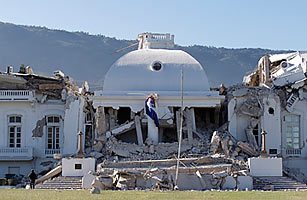
Haiti's damaged presidential palace
The tragedy of the earthquake that struck Haiti on Tuesday is easy to measure in the lives lost, homes destroyed and infrastructure wrecked. The paradox of the quake is equally evident: when a natural disaster so devastating hits, oughtn't we have some way of predicting it? Hurricanes, blizzards, even volcanoes can be forecast well before their arrival, after all, allowing governments and people to make lifesaving preparations. Earthquakes, however, are stealth disasters, geological phenomena largely undetectable until just seconds before they occur. What scientists have long wanted to know is why quakes are so sneaky and what, if anything, can be done to read their warning signs better.
If any earthquake ought to have been predictable, it was the one that just struck. Haiti sits over two clashing tectonic plates, the North American and the Caribbean, which form what's known as the Enriquillo-Plantain Garden Fault. Geologists know the fault well and have studied it for decades, and well they should: it has shaken the region violently and repeatedly over history, though yesterday's quake, measuring 7.0 on the Richter scale, is the worst in a century.
"The plates are shearing the island, grinding it and crushing it," says geophysicist Michael Blanpied of the U.S. Geological Survey (USGS). "As that happens, earthquakes pop off."
Monitoring zones like this around the world to get a general sense of where the next such pops may happen is not that difficult, mostly because tectonic activity is hard to conceal completely. There are three types of quakes: the dip-slip fault (in which one clashing plate slides under the other), the reverse dip-slip (in which they pull apart) and the strike-slip (a sideways grinding of the plates). Haiti's quake was a strike-slip, but all three varieties are preceded by years or centuries of accumulated stress, in which the slowly drifting slabs of planet try to shift their position but remain hung up on one another. The quake occurs when that rock lock is broken. Seismometers can detect the years of stirrings that lead up to that moment, providing some help to geologists.
"We can say things generally about earthquakes," says Blanpied. "We look at faults and patterns of quakes over many years and say where on the landscape they're likeliest to occur next. This forecasting is usually in the long term." Indeed, scientists predicted as recently as 2008 that a fault zone on the south side of Haiti's island of Hispaniola posed a "major seismic hazard."
The problem is, long-term forecasting does not do much to keep people from putting themselves in harm's way. If it did, nobody would live in California or Mexico City or parts of Japan. What's needed is short-term forecasting on the order of weeks, days or hours. And this has stymied scientists again and again.
In the 1980s, for example, the USGS partnered with the state of California to study a particularly unstable stretch of the San Andreas fault near the town of Parkfield. Quakes had been occurring in the area every 20 to 25 years or so. The previous one had been in 1966, so scientists predicted another should hit before 1990. They threaded the region with seismometers and other sensors, then sat back and waited for the telltale signal that would give them notice of the coming rumble. The quake never occurred in the 1980s, nor in the 1990s. It was not until 2004 that the earth in the area at last moved again. And what did all the high-tech hardware reveal? Nothing.